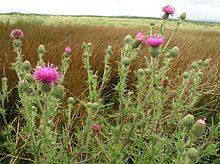- Cirsium hydrophilum
-
Cirsium hydrophilum 
Suisun thistle Conservation status Scientific classification Kingdom: Plantae (unranked): Angiosperms (unranked): Eudicots (unranked): Asterids Order: Asterales Family: Asteraceae Tribe: Cynareae Genus: Cirsium Species: C. hydrophilum Binomial name Cirsium hydrophilum
(Greene) Jeps.Cirsium hydrophilum is a species of thistle which is endemic to California, where it is found only in the San Francisco Bay Area and the Sacramento-San Joaquin River Delta. This native thistle grows in wet boggy habitats.
Contents
Description
The Cirsium hydrophilum thistle may reach 2 metres (6.6 ft) in height with a branching, cobwebby stem. The leaves are longest near the base of the plant, approaching 90 centimetres (35 in) in length. They are cut into toothed lobes and covered in spines, particularly along the petiole.
The inflorescence bears one or more flower heads, each up to 3 centimetres (1.2 in) long. The head is lined with sticky, twisted, spiny phyllaries and contains pink to purple flowers. The fruit is an achene a 2–4 millimetres (0.079–0.16 in) long topped with a pappus of about 1.5 centimetres (0.59 in) centimeters.
Varieties
There are two very localized varieties:
- The rare Cirsium hydrophilum var. hydrophilum, the Suisun thistle, is known from two occurrences in the Suisun Marsh, in the salt marsh habitat of the Delta. It is treated as a federally listed endangered species.[1]
- The very rare Cirsium hydrophilum var. vaseyi, Mt. Tamalpais thistle or Vasey's thistle, is known from about twenty occurrences on Mount Tamalpais in Marin County, in water seeps on the serpentine soils of the mountain. It is currently not a listed federal or state endangered species. [2]
References
External links
- Jepson Manual Treatment - Cirsium hydrophilum
- USDA Plants Profile: Cirsium hydrophilum
- Flora of North America: Cirsium hydrophilum
- The Nature Conservancy-NatureServe: Cirsium hydrophilum]

This Cynareae article is a stub. You can help Wikipedia by expanding it.

